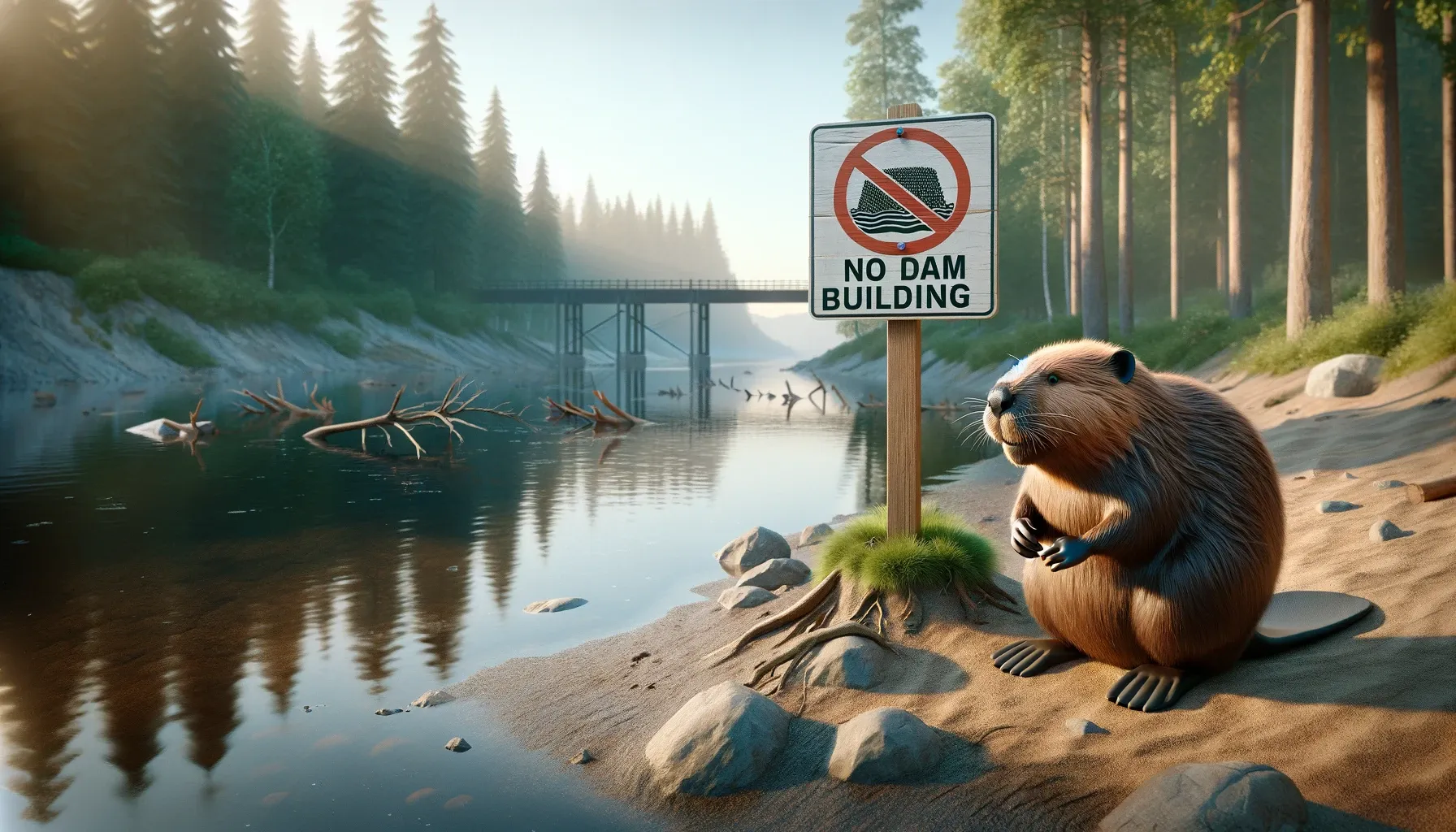Beavers are remarkable creatures, but their habit of building dams can sometimes cause problems. In this article, we will explore practical tips and effective methods to manage beaver activity on your property.
Key Takeaways:
- Preventing beaver dam construction requires a peaceful and environmentally friendly approach.
- Installing culvert guards or grills can prevent beavers from obstructing culverts with their dams.
- Culvert fences made of reinforced steel mesh or wire can keep beavers away from culverts.
- Wire mesh culvert extensions create barriers that are too large for beavers to block.
- Protecting trees from beaver damage can be achieved through homemade tree guards or by painting the base of trees with a mixture of sand and exterior latex paint.
- Peacefully coexisting with beavers is important to maintain balance in the ecosystem.
Understanding Beaver Behavior
Before we dive into ways to stop beavers from building dams, it’s important to understand their behavior and the reasons behind their dam-building instinct.
Beavers are highly skilled engineers, using their large front teeth and powerful jaws to fell trees and construct dams.
They are driven by their need for shelter, protection, and access to a reliable food source.
Beavers build dams primarily to create deep water habitats, known as beaver ponds, which provide them with safety from predators and easy access to food.
These habitats also benefit other wildlife by creating diverse ecosystems that support a variety of plant and animal species.
However, when beavers build dams in unwanted areas, such as culverts or near human infrastructure, it can lead to significant problems.
To deter beavers from constructing dams, various natural control methods can be employed. These include using deterrents such as beaver-repelling scents, sound devices, or visual deterrents that mimic the presence of predators.
By creating an environment that is less desirable for beavers, these methods can help discourage dam-building activity.
It’s important to note that each situation may require a unique approach, and consulting with beaver management experts can provide valuable guidance.
| Deterrents for Beaver Dam Construction | Natural Beaver Control Methods |
|---|---|
| Beaver-repelling scents | Creating an environment that is less desirable for beavers |
| Sound devices | Using deterrents that mimic the presence of predators |
| Visual deterrents |
Protecting Culverts
Culverts are often prime targets for beaver dam construction, but there are effective strategies you can use to protect them and keep the water flowing smoothly.
One method is to install culvert guards or grills on the upstream end of the culvert. These guards act as barriers, preventing beavers from constructing dams inside the culvert.
Another option is to use culvert fences made of reinforced steel mesh or wire. These fences are installed around the culvert, creating a physical barrier that deters beavers from approaching.
The sturdy construction of these fences ensures that beavers are unable to breach them, providing long-term protection for the culvert.
Table: Comparing Culvert Protection Methods
| Protection Method | Effectiveness | Cost | Ease of Installation |
|---|---|---|---|
| Culvert Guards | High | Low | Easy |
| Culvert Fences | Medium | Medium | Moderate |
- Culvert Guards: These devices are highly effective in preventing beavers from building dams inside culverts. They are relatively low-cost and easy to install, making them a popular choice for culvert protection.
. - Culvert Fences: While not as effective as culvert guards, fences made of reinforced steel mesh or wire can still deter beavers and provide some level of protection for the culverts. The cost and installation complexity are moderate compared to other methods.
By incorporating these strategies into your beaver management plan, you can safeguard culverts from dam construction and ensure the proper flow of water.
Remember, peaceful coexistence with beavers is key, and using these methods allows for a harmonious balance between human needs and the natural behavior of these remarkable animals.
Using Wire Mesh Culvert Extensions
An innovative solution to preventing beavers from plugging culverts is the use of wire mesh culvert extensions, which create a barrier that beavers can’t overcome.
These extensions are designed to fit over the end of a culvert, effectively enlarging the opening and preventing beavers from obstructing the flow of water.
By installing wire mesh culvert extensions, you can protect culverts from beaver dam construction and ensure the smooth passage of water.
Wire mesh culvert extensions are made of durable materials, such as galvanized steel, that are resistant to beaver gnawing.
The mesh is tightly woven to form a barrier that beavers cannot chew through or manipulate. By extending the length of the culvert, wire mesh extensions make it physically impossible for beavers to plug the culvert with their dams.
These culvert extensions are simple to install and can be customized to fit various culvert sizes. They can be attached to the upstream end of the culvert using fasteners or clamps, ensuring a secure fit.
Wire mesh culvert extensions provide a cost-effective and long-term solution for preventing beavers from interfering with culverts, reducing the need for frequent maintenance and repairs.
Table: Benefits of Using Wire Mesh Culvert Extensions
| Benefits | Description |
|---|---|
| Prevents dam construction | The mesh barrier stops beavers from building dams within culverts, maintaining water flow. |
| Durable and resistant | Wire mesh culvert extensions are made of galvanized steel, which is strong and resistant to beaver gnawing. |
| Customizable | Extensions can be tailored to fit different culvert sizes, ensuring a proper fit. |
| Cost-effective | Installing wire mesh culvert extensions provides a long-term solution, reducing the need for frequent maintenance and repairs. |
By utilizing wire mesh culvert extensions, you can effectively prevent beaver dam construction and protect culverts from blockage.
This eco-friendly method allows for the peaceful coexistence of beavers and human infrastructure, ensuring the smooth flow of water and minimizing potential damage caused by beaver activity.
Protecting Trees from Beaver Damage
Beavers have a natural tendency to chew on trees, but there are ways to protect your precious foliage from their activity.
By implementing effective beaver management strategies, you can safeguard your trees and maintain a harmonious environment. Here are some methods you can consider:
- Homemade Tree Guards: Constructing tree guards using galvanized welded wire can create a physical barrier around the base of your trees, preventing beavers from reaching the bark. This simple and cost-effective solution can be customized to fit different tree sizes and effectively deters beavers.
. - Painting the Base: Another option to protect your trees is to paint the base with a mixture of coarse mason’s sand and exterior latex paint. This creates a rough texture that discourages beavers from gnawing on the tree trunks. Regularly inspect and reapply the paint mixture as needed.
Implementing these homemade tree guards and painting methods can significantly reduce the risk of beaver damage to your trees. However, it’s important to note that peaceful coexistence with beavers is crucial in managing their activity. Respecting their natural behavior and habitat can lead to a more sustainable approach.
| Benefits of Homemade Tree Guards |
|---|
| • Cost-effective |
| • Customizable to fit various tree sizes |
| • Provides a physical barrier against beavers |
| • Helps preserve the health and aesthetics of trees |
Peaceful Coexistence with Beavers
It’s crucial to find a balance between human needs and the natural behavior of beavers, promoting peaceful coexistence rather than resorting to destructive methods.
Instead of trapping or destroying their dams and habitats, there are strategies that can help manage beaver activity while preserving their role in the ecosystem.
Alternative Techniques for Beaver Dam Removal
When it comes to beaver management strategies, beaver dam removal techniques should prioritize long-term solutions that respect the beavers’ presence.
One effective method is the use of flow devices, which regulate water levels and prevent excessive flooding without disturbing the beavers’ habitats.
Avoiding direct confrontation is key, which is why beaver management experts can play a crucial role in implementing eco-friendly prevention solutions.
These experts have the knowledge and experience to assess the situation and provide guidance on the most suitable techniques for managing beaver populations without causing harm.
Additional Tips for Peaceful Coexistence
- Regular monitoring of beaver activity can help detect issues early on and take appropriate action.
- Using scent deterrents, such as beaver-repelling sprays, can discourage beavers from establishing their territories in unwanted areas.
- Creating designated beaver-friendly zones can provide a suitable habitat for beavers while minimizing potential conflicts with human activity.
| Proactive Beaver Management Tips | Benefits of Peaceful Coexistence |
|---|---|
| Install culvert guards or grills to prevent beavers from obstructing culverts. | Promotes a harmonious relationship between humans and wildlife. |
| Use wire mesh culvert extensions or enlarged cylinders to discourage beavers from blocking culverts. | Maintains the natural behavior and role of beavers in the ecosystem. |
| Protect trees with homemade guards or by applying a protective coating of sand and latex paint to the base. | Preserves valuable tree species and their ecological functions. |
The Role of Beaver Management Experts
When it comes to beaver management, consulting with experts can provide valuable insights and eco-friendly solutions to prevent beaver damage.
Beaver management experts specialize in finding effective strategies for managing beaver populations while minimizing negative impacts on human infrastructure and natural ecosystems.
These experts understand the behavior patterns of beavers and have extensive knowledge of their habitats and habitats.
They can assess the specific challenges posed by beaver activity in a given area and develop customized management plans tailored to the unique needs and circumstances.
Beaver management experts employ a range of techniques and tools to prevent beaver damage. For example, they may recommend the installation of culvert guards or grills on the upstream end of a culvert to prevent beavers from constructing dams inside.
Culvert fences made of reinforced steel mesh or wire can also be effective in keeping beavers away from culverts.
| Benefits of Consulting with Beaver Management Experts: |
|---|
| Access to specialized knowledge and expertise in beaver behavior and habitats |
| Customized management plans tailored to specific locations and circumstances |
| Utilization of eco-friendly techniques and tools |
| Minimization of negative impacts on human infrastructure |
| Promotion of peaceful coexistence with beavers |
By seeking the guidance of beaver management experts, individuals and communities can effectively manage beaver populations while promoting a harmonious balance between human needs and the natural behavior of these fascinating creatures.
Other Beaver Control Methods
While we have explored several effective strategies for preventing beaver dam construction, there are other methods you can consider to manage beaver populations on your property.
These additional techniques can complement the approaches discussed earlier and help create a balanced coexistence with these industrious creatures.
One method to manage beaver populations is through the use of pond levelers. These devices regulate water levels in ponds, discouraging beavers from building dams.
By controlling the water flow, pond levelers minimize the appeal of the area for beavers, reducing the likelihood of dam construction.
Another option is the implementation of water flow devices. These devices work by redirecting water to a specific area, away from where beavers typically construct dams.
By manipulating the water flow, water flow devices can deter beavers and encourage them to seek other locations for dam building.
Scent deterrents are also worth considering as part of your beaver management strategy. These products release strong scents that beavers find unpleasant, deterring them from an area.
Scent deterrents can be applied to trees, vegetation, or other areas prone to beaver activity, creating an inhospitable environment for dam construction.
| Control Method | Description |
|---|---|
| Pond Levelers | Regulate water levels in ponds, discouraging beavers from building dams. |
| Water Flow Devices | Redirect water to deter beavers from constructing dams in specific areas. |
| Scent Deterrents | Products that release strong scents beavers find unpleasant, deterring them from an area. |
By incorporating these additional beaver control methods into your management plan, you can enhance your efforts to prevent dam construction and manage the beaver populations on your property. Remember, a combination of strategies tailored to your specific needs and environment will yield the best results in maintaining a harmonious relationship with these fascinating animals.
Conclusion
By implementing the strategies and techniques discussed in this article, you can effectively manage beaver activity and prevent damage to your property, all while respecting the vital role beavers play in our ecosystems.
To stop beavers from building dams, various devices can be used. Culvert guards or grills can be installed on the upstream end of a culvert to prevent beavers from constructing dams inside.
Culvert fences made of reinforced steel mesh or wire can also be effective in keeping beavers away from culverts. Another method is to use wire mesh culvert extensions or enlarged cylinders that are too large for beavers to plug.
Protecting trees from beavers can be done with homemade tree guards made of galvanized welded wire or by painting the base of trees with a mixture of coarse mason’s sand and exterior latex paint.
It is important to peacefully coexist with beavers rather than attempting to remove or harm them, as trapping or destroying their dams and habitats will only lead to their eventual return and further destruction.
By employing these proactive and humane approaches to beaver dam prevention and management, you can safeguard your property from damage while also contributing to the preservation of these remarkable creatures and the ecosystems they inhabit.
FAQ
How can I stop beavers from building dams?
There are various methods you can use to prevent beavers from constructing dams. Installing culvert guards or grills on the upstream end of a culvert can prevent beavers from building inside. Culvert fences made of reinforced steel mesh or wire can also be effective in keeping beavers away from culverts. Another option is using wire mesh culvert extensions that are too large for beavers to plug.
What can I do to protect trees from beaver damage?
There are a couple of ways to protect trees from beaver damage. You can make homemade tree guards using galvanized welded wire, which create a barrier around the tree trunk. Another method is to paint the base of trees with a mixture of coarse mason’s sand and exterior latex paint. These measures help deter beavers from chewing on tree bark.
Why is it important to peacefully coexist with beavers?
Peacefully coexisting with beavers is vital because trapping or destroying their dams and habitats will only lead to their eventual return and further destruction. Beavers play an essential role in ecosystems, creating wetland habitats that benefit various species. Managing their activity in a humane and environmentally friendly way is a more sustainable approach.




